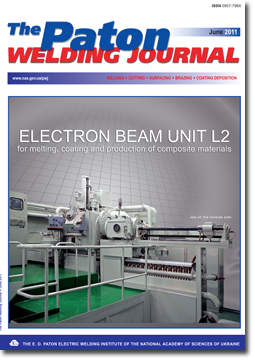| 2011 №06 (03) | 2011 №06 (05) |

The Paton Welding Journal, 2011, #6, 13-17 pages
STUDYING THE FEATURES OF MASS TRANSFER IN THE PROCESS OF FRICTION STIR WELDING USING PHYSICAL MODELLING
A.G. POKLYATSKY
E.O. Paton Electric Welding Institute, NASU, Kiev, Ukraine
Abstract
Model of the process of friction stir welding was used to study the influence of structural dimensions of working surfaces of tool shoulder and tip on the features of material displacement in the thermodynamic impact zone. It is shown that a permanent joint forms due to displacement of a certain amount of ductile material by the tool tip and its mixing across the entire thickness of edges. Shape of working surface of tool shoulder end face predetermines the displacement trajectory, movement speed, uniformity of mixing and degree of compaction of the materials being joined at solidification.
Keywords: friction stir welding, process modelling, mass transfer, tool tip design, shoulder working surface
Received: ??.??.??
Published: 28.06.11
References
1. Dawes, C.J., Thomas, W.M. (1996) Friction stir process welds aluminum alloys. Welding J., 3, 41-45.
2. Arbegast, W.J. (2006) Friction stir welding after a decade of development. Ibid., 3, 28-35.
3. Kallee, S., Nicholas, D. (1998) Causing a stir in the future. Welding and Joining, 2, 18-21.
4. Johnsen, M.R. (1999) Friction stir welding takes off at Boeing. Welding J., 2, 35-39.
5. Okamura, H., Aota, K., Ezumi, M. (2000) Friction stir welding of aluminum alloy and application to structure. J. Japan Institute of Light Metals, 4, 166-172.
6. Pietras, A., Zadroga, L., Lomozik, M. (2004) Characteristics of welds formed by pressure welding incorporating stirring of the weld material (FSW). Welding Int., 1, 5-10.
7. Colligan, K. (1999) Material flow behavior during friction stir welding of aluminum. Welding J., 7, 229-237.
8. London, B., Mahoney, M., Bingel, W. et al. (2001) Experimental methods for determining material flow in friction stir welds. In: Proc. of 3rd Int. Symp. on Friction Stir Welding (Kobe, Japan, Sept. 27-28, 2001), 1-7.
9. Dickerson, T., Shercliff, H., Schmidt, H. (2003) A weld marker technique for flow visualization in friction stir welding. In: Proc. of 4th Int. Symp. on Friction Stir Welding (Utah, USA, May, 2003), 1-12.
10. Colegrove, P.A., Shercliff, H.R. (2004) Development of trivex friction stir welding tool. Pt 1: Two-dimensional flow modeling and experimental validation. Sci. and Techn. щf Welding and Joining, 4, 345-351.
11. Shibayanagi, T. (2007) Microstructural aspects in friction stir welding. J. Japan Institute of Light Metals, 9, 416-423.
12. Tanabe, H., Watanabe, T., Yoshida, R. et al. (2007) Solid state welding between CPTi and AZ31B magnesium alloy using a rotating probe with thread. Quarterly J. JWS, 2, 386-393.
Suggested Citation
A.G. POKLYATSKY (2011) STUDYING THE FEATURES OF MASS TRANSFER IN THE PROCESS OF FRICTION STIR WELDING USING PHYSICAL MODELLING. The Paton Welding J., 06, 13-17.The cost of subscription/purchase order journals or individual articles
| Journal/Currency | Annual Set | 1 issue printed |
1 issue |
one article |
| TPWJ/USD | 384 $ | 32 $ | 26 $ | 13 $ |
| TPWJ/EUR | 348 € | 29 € | 24 € | 12 € |
| TPWJ/UAH | 7200 UAH | 600 UAH | 600 UAH | 280 UAH |
| AS/UAH | 1800 UAH | 300 UAH | 300 UAH | 150 UAH |
| AS/USD | 192 $ | 32 $ | 26 $ | 13 $ |
| AS/EUR | 180 € | 30 € | 25 € | 12 € |
| SEM/UAH | 1200 UAH | 300 UAH | 300 UAH | 150 UAH |
| SEM/USD | 128 $ | 32 $ | 26 $ | 13 $ |
| SEM/EUR | 120 € | 30 € | 25 € | 12 € |
| TDNK/UAH | 1200 UAH | 300 UAH | 300 UAH | 150 UAH |
| TDNK/USD | 128 $ | 32 $ | 26 $ | 13 $ |
| TDNK/EUR | 120 € | 30 € | 25 € | 15 € |
AS = «Automatic Welding» - 6 issues per year;
TPWJ = «PATON WELDING JOURNAL» - 12 issues per year;
SEM = «Electrometallurgy Today» - 4 issues per year;
TDNK = «Technical Diagnostics and Non-Destructive Testing» - 4 issues per year.


